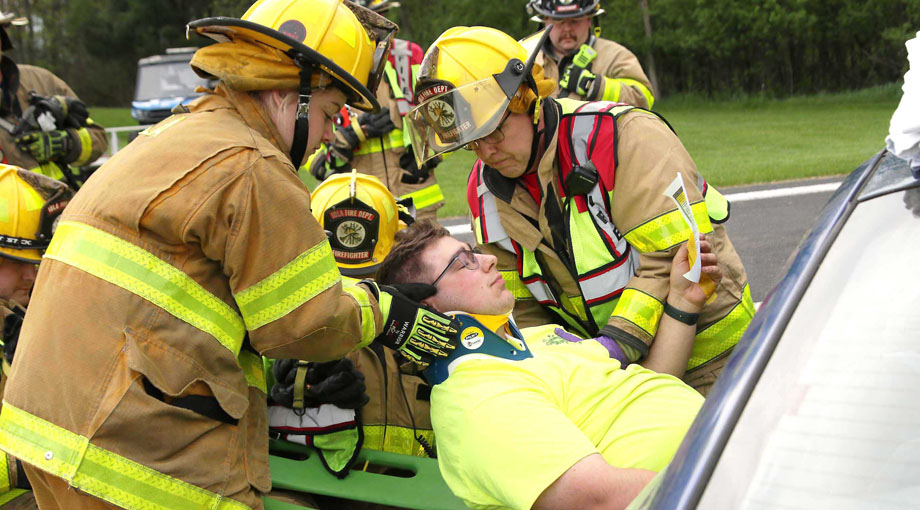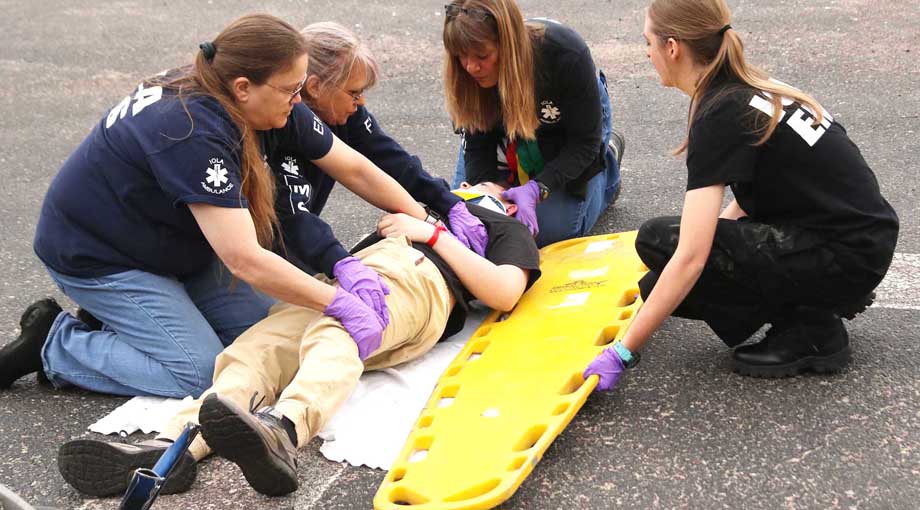
Mock event provides training
By Holly Neumann
The Iola Rural Fire and Ambulance Department gained valuable training experience May 18 while responding to a mass casualty scenario.
A simulated call was received for a vehicle vs. bicyclists accident at the intersection of State Highway 49 and County Trunk MM north of Iola.
“Upon arrival, we discovered a car which had run through several bicyclists and ended up going off the road,” Lt. Todd Snyder said. “The car had two adult and one youth patients inside of it and were not able to get out of the vehicle.”
The Jaws of Life were used to gain access to the patients. The doors were pried open and cut off, the windshield was removed and the trunk opened. One patient then asked about a baby, which prompted firefighters to search for the child while others treated the victims in the car.
The bicyclists included six adults and three youth.
“Two of these were deceased, two were critically injured and two had significant injuries,” Snyder said. “Northwest First Responders were the first on the scene, followed by our primary ambulance and rescue truck.”
The Mutual Aid Box Alarm System (MABAS) was used to get additional units from other departments for support. As the scenario evolved, additional members of the department arrived on the scene.
Some of the victims laying in the road were put in cervical collars and on backboards, while others had their arms or legs splinted.
The scenario continued until all of the patients had been initially assessed and cared for.
“Even though we work on our individual and group skills required for motor vehicle accidents throughout the year, this scenario allowed us to scale it up to a larger situation, which called for a higher level of coordination and communication among the scene’s leaders,” Snyder said.

Performing triage
The exercise allowed department members to refresh some of basic skills and work on skills such as performing medical triage or firefighters crossing over to do more medical work than they typically do at an accident scene. It also gave them familiarization with how a larger scene is structured and run differently than a traditional scene.
“This is also an opportunity for our leaders to manage a larger, more complex scene using some of the concepts related to the Incident Command System,” Snyder said.
The newest members of the department can gain as much or even more from this kind of training, according to Snyder.
“Since the scenario we use tiered responses,” he said. “Some members will be responding right away, while others won’t respond until the scene has evolved some. We try to match our less-experienced members up with someone who has been around the block a few times and place both of them in a role where they respond later in the scene.”
This allows experienced members to mentor the newer ones as the scene is evolving, letting them know what is going on and why that is happening.
“When it is their time to respond, we try to have them work on less complex parts of the scene,” Snyder said. “The mentor can work with that newer member to allow them to gain some experience in a realistic situation.”
A few of the members have not been through any initial training yet, Snyder said.
“Those members were able to observe the overall scene with members there to answer questions they had along the way,” he said.
The training helps prepare the department if an incident such as this were ever to happen.
Preparing for real scenarios
“This is the premise behind most of the simulations or scenario work we do throughout the year,” Snyder said. “By putting our members into situations that they could potentially see on a scene but doing so in a controlled, learning environment, we are able to work through those scenarios when there is little or no danger to our members and/or the lives of our victims. Since our brain doesn’t necessarily know the difference between a simulated scenario and a real one, once we get to a real scene where lives are truly at stake, it will not be as difficult for us to work through since we have already experienced it before.”
Snyder said the perception some people have about smaller, rural fire and ambulance departments is not always accurate.
“I think people often look at them as more of some community members get together once in awhile to review some basic skills,” he said. “When there is a fire, they can go spray some water on things or when there is an ambulance call, we go get the patient to drive them to the hospital.
“This is far from the truth,” he added. “Even though we are a small department, we are called upon to do the same types of incidents and medical emergencies as larger departments. Because of this, we take our training and responses very seriously. We work hard to keep our skills at a level where we can successfully respond to most any type of call we are asked to take care of. We challenge ourselves to be as proficient as we can about fire science and tactics, rescue responses and all types of medical emergencies and procedures.”
Anyone wishing to join the department can reach out to another member, call 715-445-2515 or send an email to [email protected] to receive more information.
Snyder believes smaller fire and ambulance departments offer a closer family atmosphere and sense of community than many larger departments can.
“At the end of the day, our main goal is to be able to provide the best possible protection and service to our community as we can,” he said. “To top this all off, we do all of this while having another job during the rest of the day. It is a challenge that each of our members take on with pride and enjoyment.”
